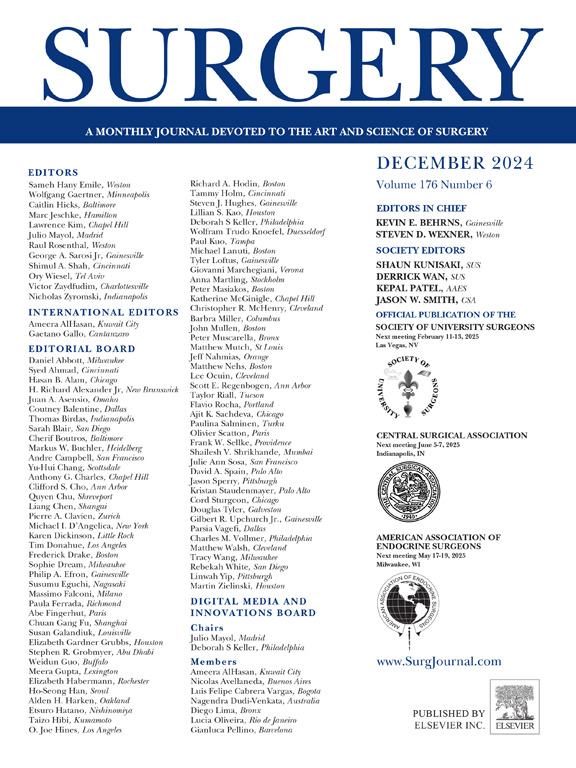主要儿童医院食道闭锁修补术婴儿的资源利用
IF 2.7
2区 医学
Q1 SURGERY
引用次数: 0
摘要
食管闭锁伴或不伴气管食管瘘是一种资源密集型的新生儿外科疾病;然而,机构成本负担的大小还没有得到很好的理解。在这项研究中,我们使用一个国家数据库来衡量全国主要儿童医院与食管闭锁初始管理相关的资源使用情况。方法查询儿童健康信息系统数据库中2014年至2021年间在美国47家儿童医院中的1家接受食管闭锁修复的婴儿。同时进行心脏手术者排除在外。主要结局指标是指数住院期间调整后的总费用(以美元计)。进行多变量线性回归分析(P <;. 05)。结果1346例食管闭锁患儿中,993例(73.8%)符合纳入标准。每位患者的平均费用为545,000美元(四分位数范围为302,000美元至1,130,000美元)。房费(中位数39.1万美元;四分位数区间(21.9万美元至84.1万美元)占总成本的近四分之三。机构手术量与医院费用之间无相关性。长间隙病(β: 867.3, P <;0.0001)是与住院费用增加相关的最重要术前因素。与成本增加相关的主要术后事件是机械通气天数(β: 17.7, P <;0.0001),肺炎(β: 168.6, P = 0.006),吻合口漏(β: 137.2, P = 0.003)。结论:在这项多中心队列研究中,新生儿食管闭锁手术治疗的中位费用超过50万美元。制定食管闭锁特异性临床实践指南,旨在降低术后呼吸系统发病率和吻合口漏率,可能有助于减少与这些具有挑战性的患者的护理相关的资源负担。本文章由计算机程序翻译,如有差异,请以英文原文为准。

Resource use in infants undergoing esophageal atresia repair at major children's hospitals
Background
Esophageal atresia with or without tracheoesophageal fistula is a resource-intensive neonatal surgical condition; however, the magnitude of the institutional cost burden is not well understood. In this study, we used a national database to measure resource use associated with the initial management of esophageal atresia at major children's hospitals nationwide.
Methods
The Pediatric Health Information System database was queried for infants undergoing esophageal atresia repair at 1 of 47 children's hospitals in the United States between 2014 and 2021. Those undergoing concomitant cardiac surgery were excluded. The primary outcome measure was total adjusted cost (in US dollars) during the index hospitalization. Multivariable linear regression analyses were performed (P < .05).
Results
Of 1,346 infants with esophageal atresia who were identified, 993 (73.8%) met inclusion criteria. The median cost per patient was $545,000 (interquartile range, $302,000–$1,130,000). Room charges (median $391,000; interquartile range, $219,000–$841,000) accounted for nearly three-quarters of total costs. There was no correlation between institutional surgical volume and hospital cost. Long-gap disease (β: 867.3, P < .0001) was the most significant preoperative factor associated with increased hospital cost. The major postoperative events associated with increased cost were mechanical ventilation days (β: 17.7, P < .0001), pneumonia (β: 168.6, P = .006), and anastomotic leak (β: 137.2, P = .003).
Conclusion
In this multicenter cohort study, the median cost associated with the surgical management of a newborn with esophageal atresia exceeded a half a million dollars. The development of esophageal atresia–specific clinical practice guidelines aimed at reducing postoperative respiratory morbidity and anastomotic leak rates may be useful to minimize the resource burden associated with the care of these challenging patients.
求助全文
通过发布文献求助,成功后即可免费获取论文全文。
去求助
来源期刊

Surgery
医学-外科
CiteScore
5.40
自引率
5.30%
发文量
687
审稿时长
64 days
期刊介绍:
For 66 years, Surgery has published practical, authoritative information about procedures, clinical advances, and major trends shaping general surgery. Each issue features original scientific contributions and clinical reports. Peer-reviewed articles cover topics in oncology, trauma, gastrointestinal, vascular, and transplantation surgery. The journal also publishes papers from the meetings of its sponsoring societies, the Society of University Surgeons, the Central Surgical Association, and the American Association of Endocrine Surgeons.
 求助内容:
求助内容: 应助结果提醒方式:
应助结果提醒方式:


